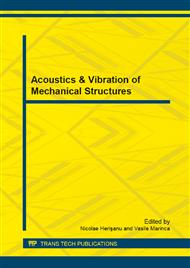p.290
p.297
p.305
p.312
p.317
p.323
p.329
p.335
p.342
Analysis of the Dynamic Behavior of the Antiseismic Elastomeric Isolators Based on the Evaluation of the Internal Dissipated Energy
Abstract:
The method of testing the elastomeric isolators at shearing, in a system formed of two elements in parallel, is presented. The exterior actions can be represented by harmonic functions defined as:kinematic excitation through the instantaneous displacement of the form (t)=Asinωt;dynamic excitation through the instantaneous force of the form F(t)=F0sintωt or P(t)=m0rω2sintωt.The linear viscoelastic behavior of the elastomer enables the obtainment of hysteresis curves of elliptical shape for each harmonic loading.In the end, the dynamic stiffness as well as the equivalent damping can be evaluated, with the mention that the stand testing individualizes the dynamic system only through viscous, elastic and inertial forces. Due to this reason, the 1st order differential equation eliminates the definition of the critical damping ratio as for a second order system, which leads to the introduction of the concept of equivalent damping, originating in the hysteretic damping or the loss factor.
Info:
Periodical:
Pages:
317-322
Citation:
Online since:
September 2013
Authors:
Price:
Сopyright:
© 2013 Trans Tech Publications Ltd. All Rights Reserved
Share:
Citation:


